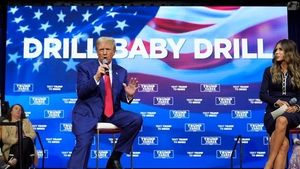On September 5, 2025, ARK Invest CEO Cathie Wood delivered a striking prediction: artificial intelligence and a suite of breakthrough technologies could soon trigger a historic leap in U.S. productivity, potentially pushing inflation down to zero—or even into negative territory. Speaking candidly on her widely followed show, In the Know, Wood argued that the United States is on the cusp of an economic transformation, with technology-enabled innovation acting as a powerful deflationary force across the economy. Her remarks come at a moment when the nation’s economic headlines are anything but unified, with some outlets painting a far gloomier picture of growth under President Donald Trump’s administration.
Wood, who has become something of a bellwether for innovation-focused investors through her stewardship of the ARK Innovation ETF, didn’t mince words about the scale of change she expects. "Technologically enabled innovation is deflationary by nature," she explained, pointing to artificial intelligence, robotics, energy storage, multiomics, and blockchain as the main drivers. According to Benzinga, Wood emphasized that as these technologies mature, learning curves will drive down costs, creating a “powerful deflationary effect” even as tariffs and high interest rates continue to weigh on American households.
But what’s behind this wave of optimism? Wood sees the roots in a combination of technological progress and recent policy shifts. She drew a direct line between the current productivity outlook and deregulatory moves under President Trump, highlighting changes in nuclear energy, cryptocurrency, and artificial intelligence regulations. In addition, new tax rules that allow for accelerated depreciation of manufacturing and research and development investments are, in her view, poised to spark “an explosion in manufacturing capacity and all other kinds of investing” over the next few years.
“AI can’t catalyze itself,” Wood noted, but she was quick to add that “all of the other platforms are being catalyzed and I think the speed of change is going to be pretty shocking over the next few years.” Her belief is that these incentives will make the U.S. more competitive, especially in attracting foreign direct investment. She estimated that effective U.S. tax rates could drop to about 12%, rivaling Ireland and undercutting even Hong Kong—a bold claim that, if realized, could dramatically reshape the global investment landscape.
Wood’s bullishness extends to her outlook for overall economic growth. She projected that real GDP growth could reach an eye-popping 5% to 7% annually in the coming years, driven by rising productivity and demographic shifts. “Technology is a net job creator,” she asserted, arguing that automation and AI will more than offset labor shortages caused by retiring baby boomers. For those worried that robots and algorithms might spell doom for workers, Wood’s message was clear: innovation will create more jobs than it destroys, echoing a debate that has raged since the dawn of the Industrial Revolution.
To put things in perspective, Wood compared the current innovation cycle to the internet boom of the late 1990s. “We are today where we were with the internet in 1995,” she observed, suggesting that the U.S. is entering “prime time” for innovation-led growth. While she cautioned that the early phases of such cycles are often marked by volatility, the long-term trajectory, in her view, will be nothing short of transformative. Those who remember the dizzying highs and lows of the dot-com bubble might feel a sense of déjà vu—but Wood’s optimism is rooted in the belief that this time, the underlying technologies are even more potent and pervasive.
However, not all analysts are singing from the same hymn sheet. Just days before Wood’s remarks, the release of second-quarter U.S. Gross Domestic Product (GDP) figures on August 28, 2025, sparked a wave of conflicting headlines. As reported by MSNBC, one particularly stark assessment read: “Trump’s agenda is strangling growth, raising costs and killing jobs.” This headline encapsulates the skepticism among some commentators, who see recent economic data as evidence that the administration’s policies are backfiring, rather than laying the groundwork for a new era of prosperity.
The numbers themselves paint a mixed picture. According to Benzinga, the August 2025 U.S. jobs report revealed a sharp slowdown in hiring, with only 22,000 jobs added—far below the 75,000 that economists had expected. Even more concerning, revisions showed that June payrolls had actually slipped into negative territory, while July’s gains received only a modest upgrade. Healthcare and social assistance were the main engines of job growth, but private payrolls weakened and government jobs contracted. The unemployment rate ticked up to 4.3%, and wage growth cooled slightly, adding to concerns about the strength of the recovery.
These developments have not gone unnoticed by financial markets, which are now betting heavily on near-certain Federal Reserve rate cuts in September, and possibly again in October. The prospect of looser monetary policy has already sent stocks, Treasuries, and gold to record highs, as investors anticipate a fresh round of stimulus to counteract the slowdown. Yet for many ordinary Americans, the disconnect between surging asset prices and the reality of a sluggish job market remains palpable.
So, which narrative should readers believe—the vision of explosive, innovation-driven growth, or the warnings of policies that are “strangling” the economy? The answer, as is so often the case, is likely to be complicated. On one hand, Wood’s argument that technology is inherently deflationary and a net creator of jobs is supported by decades of economic research. The learning curves she cited—whereby costs fall as experience with a technology accumulates—have played out time and again, from semiconductors to solar panels. Her projection that the U.S. could become a magnet for foreign direct investment, thanks to lower effective tax rates and deregulation, is plausible, though far from guaranteed.
On the other hand, the immediate data from the labor market and GDP reports suggest that the transition may not be smooth. The economy is clearly grappling with headwinds, including higher interest rates, persistent tariffs, and global uncertainty. Critics of the administration warn that the costs of these policies are already being felt in the form of slower growth and rising economic anxiety. The MSNBC headline, while perhaps hyperbolic, reflects genuine concerns among some economists and policymakers that the benefits of innovation may not be evenly distributed—or may take longer to materialize than optimists hope.
What’s clear is that the stakes could hardly be higher. As policymakers, investors, and ordinary citizens alike look to the future, the tension between short-term challenges and long-term opportunities will be at the heart of the national conversation. Will the U.S. economy ride a new wave of technological progress to unprecedented heights, or will policy missteps and structural headwinds hold it back? For now, the answer remains uncertain, but the debate itself underscores just how much is riding on the choices made in the months and years ahead.
As the dust settles on this latest round of economic data and expert predictions, one thing is certain: the coming years will test the resilience, adaptability, and innovative spirit of the American economy like never before.



